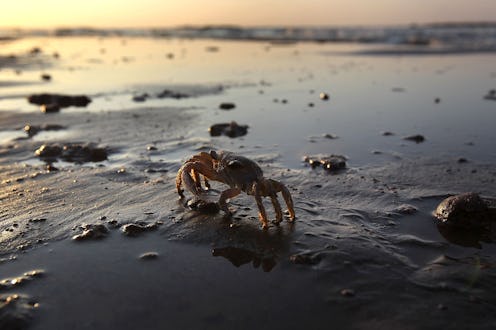News
These Vampire Crabs Are Super Spooky — PHOTOS
With a purple body, pink claws, and glowing yellow eyes, two new species of the vampire crab have been discovered in Indonesia. Already popular pets, researchers traced the mysterious origins of the colorful crustaceans to Southeast Asia where they live in two separate river valleys. Their glowing eyes and overall spooky appearance gave them the fitting name of "vampire crab."
According to National Geographic, scientists have identified other species of vampire crabs before, but the two newly discovered varieties are the most common among pet owners. The new species, Geosesarma dennerle and Geosesarma hagen, were found in river valleys on the Indonesian island of Java that lies between Singapore and Australia. Their eye-catching appearances, with the G. dennerle's deep purple shell and cream-colored spot on its back and the G. hagen's bright orange coloring, explain the attraction for people with aquariums. The creatures are also the perfect size for living in a small tank, as they're usually less than an inch wide.
These vampire crabs were discovered by professional-aquarist-turned-crab-hunter Christian Lukhaup, who published a study on the species along with Christoph Schubart. Lukhaup, ironically born in Transylvania (Dracula's home), used his contacts in the aquarium industry to find collectors who might have information about the crabs' origins, tracking them to the island of Java. In an interview with National Geographic, Lukhaup says:
These crabs are kind of special because they've been around in the pet trade for ten years, but no one knew where they come from.
The spooky crustaceans' unique coloring comes from the time they spend on land. To National Geographic, Schubart says:
There's much more emphasis on color and visual cues rather than chemical cues, as used in the water.
Regardless of the evolutionary reasoning, their bright purple and orange shells make the crabs extremely appealing to people collecting exotic animals for an aquarium. Schubart says:
Dealers working in Southeast Asia and other parts of the world know what their clients are looking for in terms of colors. They start collecting in areas where scientists may not have made any expeditions so far, and suddenly the market is formed with some animals that no one has ever given a name.
According to National Geographic, Schubart, the study's co-author, believes there are more undiscovered species of vampire crabs on the Indonesian islands. Because they dwell in freshwater, and not the ocean, the different species stay in one area, and many of the islands of Indonesia have their own distinct species of vampire crab. The two new species likely don't exist outside of a single watershed, making them extremely vulnerable to crab collectors. Schubart says:
For the local collectors, it's their living. They just catch what they can get and export it.
These exotic creatures could become extinct if they continue to be popular pets. Lukhaup hopes that commercial breeding will prevent that from happening, but few individuals are breeding the crabs so far.
